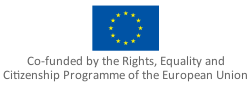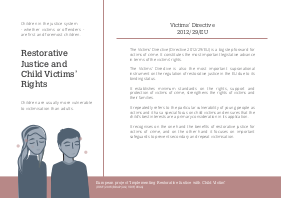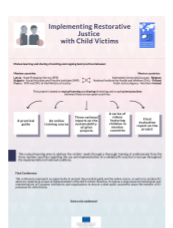
Microsite Implementingrj
Introduction
The Directive establishing minimum standards on the rights, support and protection of victims of crime (hereafter, the ‘Victims Directive’), adopted on 25th October 2012, strengthens the rights of victims and their families to information, support and protection, and lays out the procedural rights of victims when participating in criminal proceedings. It expects EU Member States (EUMS) to ensure that professionals are trained on victims’ needs.
Concretely, article 12 of The Directive establishes the right of victims to safeguards to ensure that «victims who choose to participate in restorative justice processes, have access to safe and competent restorative justice services». The Directive defines restorative justice (RJ) as «any process whereby the victim and the offender are enabled, if they freely consent, to participate actively in the resolution of matters arising from the criminal offence through the help of an impartial third party» (article 2).
Research in Europe and in other regions has revealed that victims report lower levels of fear and post-traumatic stress symptoms after a restorative justice process. Furthermore, these kinds of processes play a major role in enhancing guarantees for children and young people involved in the process, both as perpetrators and victims of harm, who may have particular vulnerabilities due to their young age.
The outcomes of such a process must be to restore as much as possible what has been lost, damaged or violated. Victims can regain some power over their lives by having the person who harmed them accountable directly to them, by receiving answers to their questions, and by telling their story of the harm and its impact. These needs are also met through apology, reparation and compensation. All these processes require communication, preferably face-to-face, between the parties.
The proactive attitude of European institutions on children’s rights in general, as well as child-friendly justice and victims' protection in particular, has created a favourable environment in the EU for justice reforms. However, in Europe far too few people who have been harmed participate in such meetings with those who have harmed them. Justice, education and other key systems seem reluctant, usually due to a lack of knowledge and experience about RJ, to enable most victims to gain access to restorative processes.
This context is the reason why the IJJO is launching the project ‘Implementing Restorative Justice with Child Victims’ (JUST/2015/RDAP/AG/VICT/9344). Its main objective will be to extend and adapt the research on RJ to demonstrate its effectiveness for young victims. Collaborating with the European Forum for Restorative Justice (EFRJ) on this project, the IJJO has decided to use the strength of two big European networks together and the experience and knowledge of the EFRJ on restorative justice to implement successful practices of juvenile restorative justice in the EU, in order to address the needs of young victims of crime committed by young offenders in the most satisfying ways.
The project will provide an opportunity for mutual learning between six countries, three of which are already using restorative justice with children successfully (the “mentor” partners), and the other three will implement observed restorative practices as part of a monitored pilot project (the “mentee” partners). In addition, in order to provide knowledge about good practices to a large pool of professionals, a practical guide on how to implement three RJ practices with children and youth will be created, and an online course will be developed based on it.


